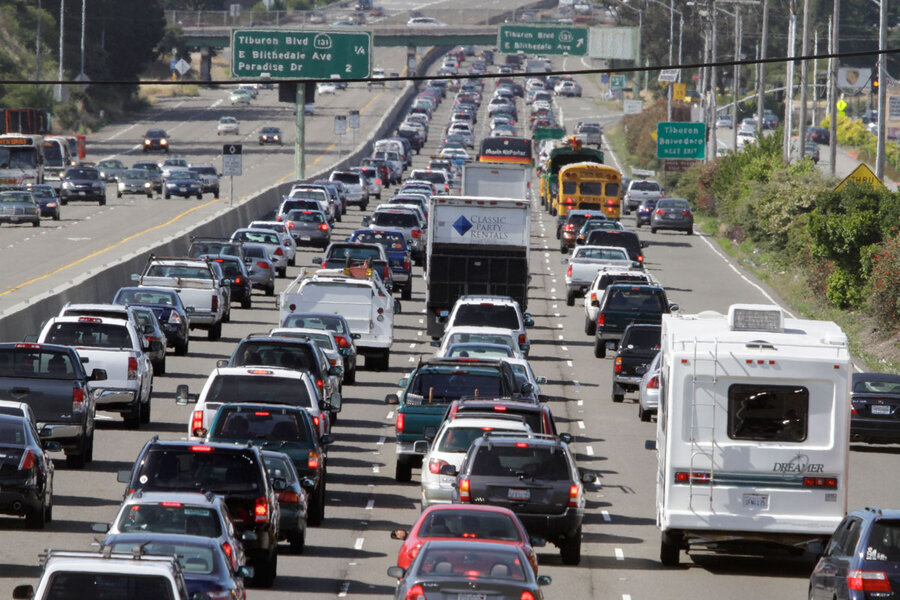As traffic deaths rise, will public warm to driverless cars?
Loading...
While major tech companies, automakers, and the US government are pursuing the emerging market of self-driving cars, public policy experts say consumers may slow the pace of change.
The National Safety Council, a nonprofit organization, said Wednesday that an estimated 40,000 Americans died from traffic accidents in 2016, a 6 percent jump from the previous year. That number, which makes 2016 the deadliest year on US roads in nearly a decade, underscores the need for rapid adoption of new automotive safety technologies, NSC said. While carmakers and industry experts hope the push for such technologies could lead to a mass adoption of autonomous cars, urban planning experts say a full embrace of the autonomous future might take longer to realize, as it faces higher hurdles in costs and policy.
Though Americans did drive more last year, as gas prices remained low, the top three causes pushing the rise in fatalities were speeding, alcohol, and distractions, according to Deborah Hersman, NSC president and chief executive officer. She adds that these safety concerns, because of drivers' bad decision-making, could be improved by newly-developed technologies, such as blind-spot monitoring and lane departure warning.
In October, together with the Department of Transportation's National Highway Traffic Safety Administration and two other agencies, the NSC announced the "Road to Zero Initiative," setting an ambitious goal of zero traffic deaths by 2046. With a $1 million grant, the NSC hopes to build a coalition that includes "develop[ing] a zero-traffic-deaths scenario through strategic deployment of self-driving cars."
While an autonomous future is achievable, to Daniel Chatman, an associate professor of urban planning at the University of California, Berkeley, who focuses on travel behavior and transportation, the “big question” is how quickly the market will grow and costs will come down.
“There is no question that autonomous cars will eliminate any causes of human errors, but how long will that take... it’s something that needs to be figured out,” he says. “I do think the promise is there."
Getting the public to embrace self-driving cars likely won't be as simple as the introduction of previous safety features to existing cars, such as air bags. Autonomous vehicles are more of a "disruptive" innovation rather than an enhancement to a product they already use, Professor Chatman says. That could be a big hurdle to overcome.
“I think the best corollary to autonomous vehicles is how long it took for people to adopt motor vehicles when they were first invented. And the answer to that, at that time in history, it was about 20 years,” he tells The Christian Science Monitor. “[But] the issue here, it's a bit different. You can look at historic examples, but it's not clear that historic examples are the right examples.”
This report comes at a time when US automakers and tech companies are pouring money into developing artificial intelligence systems for self-driving cars and sending them to the streets for testing. Key among their motives, such companies say, is the hope that these vehicles can fully eliminate human errors, which cause 80 percent of traffic deaths, according to Greg Brannon, the director of automotive engineering at the American Automobile Association (AAA).
Even Tesla's electric cars, which have an autopilot feature but are not fully autonomous, are still safer, founder and chief executive Elon Musk has argued.
"The probability of having an accident is 50 percent lower if you have Autopilot on," he said in April. "Even with our first version, it's almost twice as good as a person."
Yet, those claims are lacking crucial evidence, since there are not yet any fully autonomous cars, says Mr. Brannon.
In addition to expense, which makes driverless cars still a luxury limited to a small part of the population, automakers will also need to overcome public distrust of new technology. Despite numerous reports and coverage on the benefits of driverless cars, three-quarters of Americans still feel “afraid” to ride in one, a recent survey from AAA shows.
More positive public sentiment is critical of a full adoption of the new technology, says Chatman. While autonomous car adoption could be quicker, since the public can try driverless cars with ride-hailing services such as Uber and Lyft, as soon as a self-driving car is involved in an accident, "that is going to cause an outcry and people are going to back off from using autonomous vehicles," he says.
To Brannon, this is exactly why consumer education – not just about self-driving cars' benefits, but also on their limitations – is such an important part of the development.
"It's going to be an evolution, not a revolution, as things play out over the upcoming years," he says. "That education then plays into the more advanced self-driving vehicles because if they become comfortable with the technology that underlies it, then they will be more comfortable with the idea of the vehicle taking full control once they have the opportunity to experience these technologies at work."
While the Department of Transportation’s zero-death goal heavily relies on the auto industry’s development of self-driving cars, Chatman says the government will not and does not need to step into the market to help with funding or research, as it would be very controversial for the agencies.
"The fact is, along with autonomous vehicles, what will be happening is a significant reduction of the transportation workforce," he says. "Managing that transition to a point where one no longer needs drivers because it is cheaper to have an autonomous driver than a bus that's being driven, that's going to be a very stunning antithetical problem to work out."
Instead, Chatman says the government’s role should be to figure out how to best regulate and how to set standards, as self-driving vehicles cannot independently navigate the environment and need information from other vehicles around them.
“It's a very important role – how do you regulate these vehicles, how do you set standards so they can communicate with each other even though they were built by different companies,” he says.






